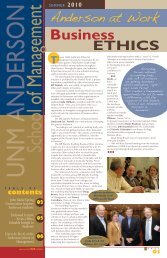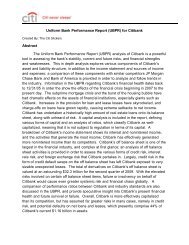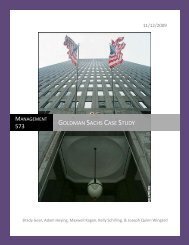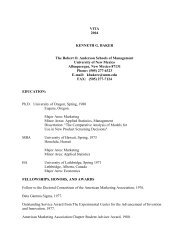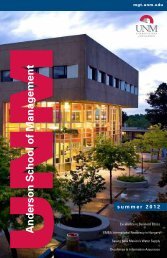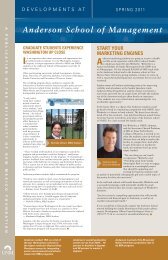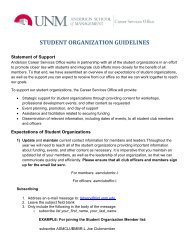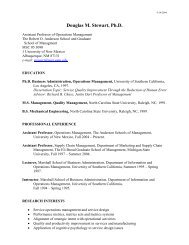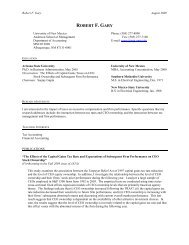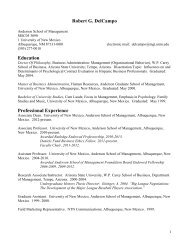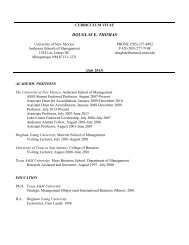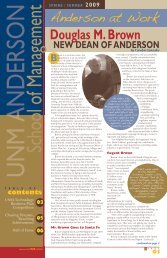Uniform Bank Performance Report - Anderson School of Management
Uniform Bank Performance Report - Anderson School of Management
Uniform Bank Performance Report - Anderson School of Management
Create successful ePaper yourself
Turn your PDF publications into a flip-book with our unique Google optimized e-Paper software.
price <strong>of</strong> the company could increase. This could result in larger capital reserve requirements, higher<br />
interest rates, and many other factors that could negatively affect the company’s pr<strong>of</strong>its.<br />
Income statement analysis <strong>of</strong> JPMC reveals that Interest revenue from loans in 2009 has been slow, yet<br />
still above that <strong>of</strong> its competitors. Service charge revenue has been high, bringing in $3.5 billion in<br />
revenue in the first half <strong>of</strong> 2009 alone. Card services are also successful and should prove to be an even<br />
bigger source <strong>of</strong> revenue as the economy continues to grow. Interest expense was low in 2009<br />
compared to prior years, while non‐interest expense has been increasing. However, the non‐interest<br />
expense statistic has been skewed by the acquisition <strong>of</strong> Bear and WaMu. Overall analysis <strong>of</strong> the income<br />
statement yields positive results.<br />
Balance sheet analysis shows an abundance <strong>of</strong> toxic assets held by JPMC. These have caused the bank to<br />
raise their provisions for credit losses account to over $16.6 billion, meaning that the bank anticipates<br />
the continued growth <strong>of</strong> these losses. Loans made by JPMC have decreased as a result <strong>of</strong> tightened<br />
credit markets and widespread declines in the economy. This will inhibit its future growth prospects. In<br />
addition, JPMC’s investment and underwriting activities have suffered substantially. Debt and equity<br />
investments held for clients decreased by 14%, while derivative investments decreased by 40% in the<br />
most recent year. These drastic decreases reflect consumers’ loss in confidence in JPMC and the<br />
financial markets in general. However, as the economy continues to recover, these numbers may<br />
recover quickly as well.<br />
JPMC’s ROA has been steadily declining, but is on par with competitors, and appears worse than it really<br />
is due to the huge acquisition <strong>of</strong> assets from Bear Stearns and WaMu. ROE has also been in a steady<br />
decline, but is similar to that <strong>of</strong> competing banks. The NIM for JPMC is a promising statistic. Not only has<br />
it been steady and on par with competition, but has shown an increase in 2009 which shows JPMC’s<br />
ability to manage interest rate risks during volatile times.<br />
Asset quality figures do not look good, but are similar to what can be expected by a bank heavily<br />
affected by the mortgage and asset backed securities crisis. The value <strong>of</strong> JPMC’s credit portfolio is $1.92<br />
trillion, with non‐performing / past‐due receivables at $17.5 billion. However, this should not pose a<br />
deadly threat to the bank as it is still well capitalized. Capital ratios, including Tier 1, Tier 2, and Total



